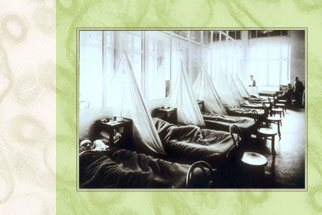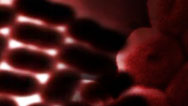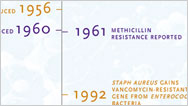Reviving the 1918 Virus
- By Peter Tyson
- Posted 11.01.06
- NOVA scienceNOW
The 1918 flu virus killed up to 50 million people worldwide. Recently, researchers sequenced this frightening germ's genome and published the data on a public database. Then other researchers used the genome to bring the long-vanished virus back to life. Was all this justified, even to help prepare for future pandemics? Read arguments for and against, then decide for yourself in our poll.
 Launch Interactive
Printable Version
Launch Interactive
Printable Version
Why recreate the deadly 1918 flu virus? In this interactive poll, explore arguments for and against then vote online.
Sources
Researchers will use the genome and revived virus to learn how to protect us from future flu pandemics.
Fauci/Gerberding: "Unmasking the 1918 Influenza Virus: An Important Step Toward Pandemic Influenza Preparedness," a joint statement (see http://www3.niaid.nih.gov/news/newsreleases/2005/0510state.htm)
Zerhouni: Quoted in "Mouse Study Reveals New Clues About Virulence of 1918 Influenza Virus," a National Institutes of Health press release, 27 September 2006 (see http://www.nih.gov/news/pr/sep2006/niaid-27a.htm)
Terrorists could use the genome or the recreated virus in attacks.
Caplan/McGee: "Re-creating Flu a Recipe for Disaster," Albany Times Union, 23 October 2005.
van Aken: "When Risk Outweighs Benefit: Dual-use Research Needs a Scientifically Sound Risk-Benefit Analysis and Legally Binding Biosecurity Measures," EMBO Reports, Vol. 7, Special Report, 2006, S12.
The decisions to publish the genome and recreate the virus were fully vetted with the proper authorities.
Kennedy: "Better Never Than Late," Science, 14 October 2005, 195.
Sharp: Philip A. Sharp, "1918 Flu and Responsible Science," Science, 7 October 2005, 17.
The decisions to publish the genome and recreate the virus were not properly vetted with the general public.
Hammond: Quoted in "Biosafety Irregularity in Spanish Flu Experiments Highlights the Need to Strengthen Biodefense Transparency," a Sunshine Project news release, 21 October 2003 (see http://www.sunshine-project.org/publications/pr/pr211003.html)
Caplan: Quoted in Mike Stobbe, "Researchers Reconstruct 1918 Flu Virus," Associated Press, 5 October 2005.
Terrorists would have a hard time recreating the virus from the genome.
Griffin: Quoted in Mike Stobbe, "Researchers Reconstruct 1918 Flu Virus," Associated Press, 5 October 2005.
Guilford: Quoted in Steve Gilday, "The Flu Reborn: Scientists Publish Complete Genome of 1918 Flu Virus," The Cavalier Daily, 28 October 2005
Terrorists could easily reconstruct the virus from the genome.
Brown: Quoted in Jamie Shreeve, "Why Revive a Deadly Flu Virus?," The New York Times Magazine, 29 January 2006.
Jensenius: "Vaccine Against Spanish Flu," Science, 17 March 2006, 1552.
The chances that the government's recreated virus could escape are close to nil.
Sharp: Philip A. Sharp, "1918 Flu and Responsible Science," Science, 7 October 2005, 17.
CDC: From "Questions & Answers: Reconstruction of the 1918 Influenza Pandemic Virus," a U.S. Centers for Disease Control online FAQ (see http://www.cdc.gov/flu/about/qa/1918flupandemic.htm)
The recreated virus could escape into the environment.
Rosenberg: Quoted in Andreas von Bubnoff, "Special Report: The 1918 Flu Virus Is Resurrected," Nature, 6 October 2005, 794.
Jensenius: "Vaccine Against Spanish Flu," Science, 17 March 2006, 1552.
Even if the virus got out, it would not be nearly as deadly as in 1918.
CDC: From "Questions & Answers: Reconstruction of the 1918 Influenza Pandemic Virus," a U.S. Centers for Disease Control online FAQ (see http://www.cdc.gov/flu/about/qa/1918flupandemic.htm)
Sharp: Philip A. Sharp, "1918 Flu and Responsible Science," Science, 7 October 2005, 17.
If the virus got out, it could kill millions of people around the world.
Ebright: Quoted in Jamie Shreeve, "Why Revive a Deadly Flu Virus?," The New York Times Magazine, 29 January 2006.
Kurzweil/Joy: "Recipe for Destruction," The New York Times, 17 October 2005.
Publishing the genome and how the recreation was done was responsible science.
NRC: From Committee on Genomics Databases for Bioterrorism Threat Agents, National Research Council, Seeking Security: Pathogens, Open Access, and Genome Databases (National Academies Press, 2004), 32
Fauci/Gerberding: "Unmasking the 1918 Influenza Virus: An Important Step Toward Pandemic Influenza Preparedness," a joint statement (see www3.niaid.nih.gov/news/newsreleases/2005/0510state.htm)
Publishing the genome and details about how the recreation was done was an irresponsible thing to do.
Kurzweil/Joy: "Recipe for Destruction," The New York Times, 17 October 2005.
Hammond: Quoted in "Disease by Design: 1918 'Spanish' Flu Resurrection Creates Major Safety and Security Risks," a Sunshine Project news release, 5 October 2005 (see http://www.sunshine-project.org/publications/pr/pr051005.html)
Credits
Images
- (Flu patients in World War I)
- Courtesy National Museum of Health and Medicine, Armed Forces Institute of Pathology, Washington, D.C.
- (H5N1 flu, CDC headquarters, working with 1918 virus, flu vaccine, processing SARS specimens)
- Courtesy CDC
- (inside a research facility)
- © Touhig Sion/CORBIS SYGMA
- (New York's Grand Central Station)
- © iStockphoto/sx70
- (1918 virus in mouse lung)
- From Tumpey et al., Science, 310(2005), used with permission of AAAS
- (handling anthrax letter)
- © Reuters/CORBIS
- (anthrax letter)
- Courtesy FBI
- (graves of 1918 flu victims)
- © K.Moe/Svalbard Posten/CORBIS SYGMA
- (GenBank tape with genetic data)
- © Ted Spiegel/CORBIS
Related Links
-

1918 Flu
A virus that killed up to 50 million people is brought back to life to decipher its deadliness.
-

1918 Flu: Expert Q&A
Microbiologist Terrence Tumpey, whose team revived the virus, answers questions about the 1918 flu and its recreation.
-

Killer Microbe
A relatively benign bug becomes a highly lethal pathogen, known to U.S. soldiers as Iraqibacter.
-

Arms Race With a Superbug
Certain microbes evolve defenses against every antibiotic we throw at them. Staph aureus is a sobering case in point.
You need the Flash Player plug-in to view this content.



